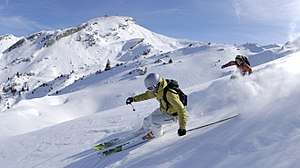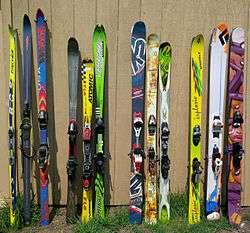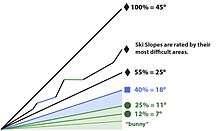Alpine skiing

Alpine skiing, or downhill skiing, is the pastime of sliding down snow-covered slopes on skis with fixed-heel bindings, unlike other types of skiing (cross-country, Telemark, or ski jumping), which use skis with free-heel bindings. Whether for recreation or sport, it is typically practised at ski resorts, which provide such services as ski lifts, artificial snow making, snow grooming, restaurants, and ski patrol.
"Off-piste" skiers—those skiing outside ski area boundaries—may employ snowmobiles, helicopters or snowcats to deliver them to the top of a slope. Back-country skiers may use specialized equipment with a free-heel mode for hiking up slopes and a locked-heel mode for descents.
Alpine skiing has been an event at the Winter Olympic Games since 1936.[1]
Participants and venues
As of 1994, there were estimated to be 55 million people worldwide, who engaged in Alpine skiing. The estimated number of skiers, who practised Alpine, cross-country skiing, and related snow sports, amounted to 30 million in Europe, 15 million in the US, and 14 million in Japan. As of 1996, there were reportedly 4,500 ski areas, operating 26,000 ski lifts and enjoying skier visits. The predominant region for downhill skiing was Europe, followed by Japan and the US.[2]
Technique
A skier following the fall line will reach the maximum possible speed for that slope. A skier with skis pointed perpendicular to the fall line, across the hill instead of down it, will accelerate more slowly. The speed of descent down any given hill can be controlled by changing the angle of motion in relation to the fall line, skiing across the hill rather than down it.
Downhill skiing technique focuses on the use of turns to smoothly turn the skis from one direction to another. Additionally, the skier can use the same techniques to turn the ski away from the direction of movement, generating skidding forces between the skis and snow which further control the speed of the descent. Good technique results in a flowing motion from one descent angle to another one, adjusting the angle as needed to match changes in the steepness of the run. This looks more like a single series of S's than turns followed by straight sections.
Stemming
The oldest and still common form of alpine ski turn is the stem, turning the front of the skis sideways from the body so they form an angle against the direction of travel. In doing so, the ski pushes snow forward and to the side, and the snow pushes the skier back and to the opposite side. The force backwards directly counteracts gravity, and slows the skier. The force to the sides, if unbalanced, will cause the skier to turn.
Carving
Carving is based on the shape of the ski itself; when the ski is rotated onto its edge, the pattern cut into its side causes it to bend into an arc. The contact between the arc of the ski edges and the snow naturally causes the ski to tend to move along that arc, slowing the skier and changing their direction of motion.
The turning snowplow is the simplest form of turning and is usually learned by beginners. To perform the turning snowplow one must be in the snowplow position while going down the ski slope. While doing this they apply more pressure to the inside of the opposite foot of which the direction they would like to turn. This type of turn allows the skier to keep a controlled speed and introduces the idea of turning across the fall line. Side slip/turning uphill: When learning to turn uphill a skier must learn how to side slip. They begin by skiing across the fall line, while skiing across the fall line they must push their ski facing the downhill side of the slope. This will cause the ski to begin to skid, when the ski skids the skier shifts their weight towards the skidding ski causing them to make a 180 degree turn towards the other direction of the fall line. These actions in a sequence are the basic method of carving while skiing. To perform an uphill turn one does the side slip method, but instead of shifting their weight over their skidding ski, they turn their skis upwards, which will cause them to stop. This method is used to slow down or stop while skiing on a slope. [3]
Equipment

Skis
Modern alpine skis are shaped to enable carve turning, and have evolved significantly since the 1980s, such as, Powder skis, Freestyle skis, All-Mountain skis, Kids skis and more.[4] Powder skis are usually used when there is a large amount of fresh snow. The reason being is the shape of a powder ski is wide allowing the ski to float on top of the snow compared to a normal downhill ski which would most likely sink into the snow. Freestyle skis are used by skiers who ski terrain parks. These skis are meant to help a skier who skis jumps, rails, and other features placed throughout the terrain park. Freestyle skis are usually fully symmetric, meaning they are the same dimensions from the tip of the ski to the backside of the ski. All mountain skis are the most common type of ski, All mountain skis tend to be used as a typical alpine ski. All Mountain skis are built to do a little bit of everything, they can be used in fresh snow (powder) or used when skiing groomers. Slalom Race Skis, or usually referred to as race skis are short narrow skis. These skis are usually on the stiffer side of rank because they are meant for those who want to go fast as well as make quick sharp turns.[5]
Bindings
The binding is a device used to connect the skier's boot to the ski. The purpose of the binding is to allow the skier to stay connected to the ski, but if the skier falls the binding can safely release them from the ski to prevent injury. There are two types of bindings: the heel and toe system (step in) and the plate system binding.[3]
Boots
Ski boots are one of the most important accessories to skiing. They connect the skier to the skis allowing them full control over the ski. When ski boots first came about they were made of leather and laces were used. The leather ski boots started off as low cut, but gradually became taller as injuries became more common allowing for more ankle support. Eventually the tied laces were replaced with buckles and the leather boots were replaced with plastic. This allowed the bindings to be much more closely matched to the fit of the boot, and offer dramatically improved performance. The new plastic model contained two parts of the boots: inner boot and outer shell. The inner part of the boot (also called the liner) is the cushioning part of the boot and contains a footbed along with cushion to keep a skier's foot warm and comfortable. The outer shell is the part of the boot that is made of plastic and contains the buckles. Most ski boots contain a strap at shin level to allow for extra strength when tightening the boots.[3]
Helmet
The purpose of ski helmets are to reduce the chances of getting a head injury while skiing. Ski helmets also help to provide warmth to the head since they consist of an inner liner that traps warmth. Helmets are available in many styles, and typically consist of a hard plastic/resin shell with inner padding. Modern ski helmets may include many additional features such as vents, earmuffs, headphones, goggle mounts, and camera mounts.[6]

Competition
Elite competitive skiers participate in the FIS World Cup, the World Championships, and the Winter Olympics. Broadly speaking, competitive skiing is divided into two disciplines:
- Racing, comprising slalom, giant slalom, super giant slalom, combined, and downhill.
- Freestyle skiing incorporates events such as moguls, aerials, halfpipe, and skicross.
Other disciplines administered by the FIS but not usually considered part of alpine are speed skiing and grass skiing.
Ski trail ratings
In most ski resorts, the runs are graded according to comparative difficulty so that skiers can select appropriate routes. The grading schemes around the world are related, although with significant regional variations. Skiers should be careful to gauge the range of trail difficulty of the mountain they are skiing and select trails rated to their ability accordingly. A beginner-rated trail at a large mountain may be more of an intermediate-rated trail on a smaller mountain.

In the United States, there are 4 rating symbols: Easy (green circle), Intermediate (blue square), and Difficult (black diamond), and Experts Only (Double-Black Diamond) Ski trail difficulty is measured by percent slope, not degree angle. A 100% slope is a 45 degree angle. In general, beginner slopes (green circle) are between 6% and 25%. Intermediate slopes (blue square) are between 25% and 40%. Difficult slopes (black diamond) are 40% and up. However, this is just a general "rule of thumb." Although slope gradient is the primary consideration in assigning a trail difficulty rating, other factors come into play. A trail will be rated by its most difficult part, even if the rest of the trail is easy. Ski resorts assign ratings to their own trails, rating a trail compared only with other trails at that resort. Also considered: width of the trail, sharpest turns, terrain roughness, and whether the resort regularly grooms the trail.
Safety
The most common types of ski injuries injure the knee, head, neck and shoulder area, hands and back. Staying in shape will help prevent skiers from getting injured. Before skiing an individual should workout and stay in shape to avoid any type of injury. Ski helmets are highly suggested by professionals as well as doctors. Head injuries caused in skiing can lead to death or permanent brain damage. Another way to stay safe while skiing, is to ski at your own ability. Skiers should know what skill level their skiing is at and should ski the runs that suit their capability.[7] In alpine skiing, for every 1000 people skiing in a day, on average between two and four will require medical attention. Most accidents are the result of user error leading to an isolated fall.[7]
See also
References
- ↑ "Alpine Skiing". International Olympic Committee. Retrieved 12 March 2010.
- ↑ Hudson, Simon (2000). Snow Business: A Study of the International Ski Industry. Tourism (Cassell). Cengage Learning EMEA. p. 27. ISBN 9780304704712. Retrieved 2018-05-15.
- 1 2 3 Karl., Gamma, (1992). The handbook of skiing (Rev. and updated ed.). New York: Knopf. ISBN 9780679743163. OCLC 25632229.
- ↑ "How to Choose Downhill Skis". REI. Retrieved 2017-12-12.
- ↑ "Skis - Ski Equipment - Mechanics of Skiing". www.mechanicsofsport.com. Retrieved 2017-11-16.
- ↑ "Ski Helmets Guide - Ski Equipment - Mechanics of Skiing". www.mechanicsofsport.com. Retrieved 2017-11-16.
- 1 2 Doyle, Mike (May 12, 2017). "Follow These Tips to Stay Safe While Skiing on the Slopes". ThoughtCo. Retrieved 2017-11-16.
External links
| Wikimedia Commons has media related to Alpine skiing. |
| Wikivoyage has a travel guide for Alpine skiing. |
- Alpine Canada Alpin - Alpine Canada Alpin, National Governing Body for Ski Racing within Canada
- U.S. Ski and Snowboard Association - The National Governing Body for Ski Racing
- U.S. Ski Team - Bio information and stories on U.S. elite athletes
- Retro Ski - ski history
- Alpine Ski Database
- Colorado Ski Museum
